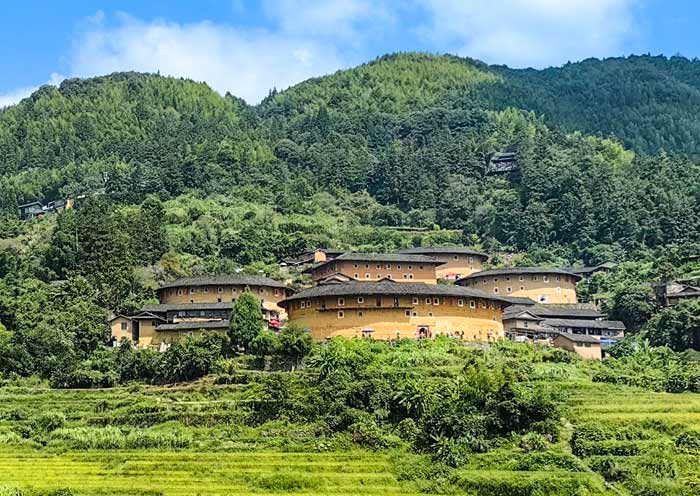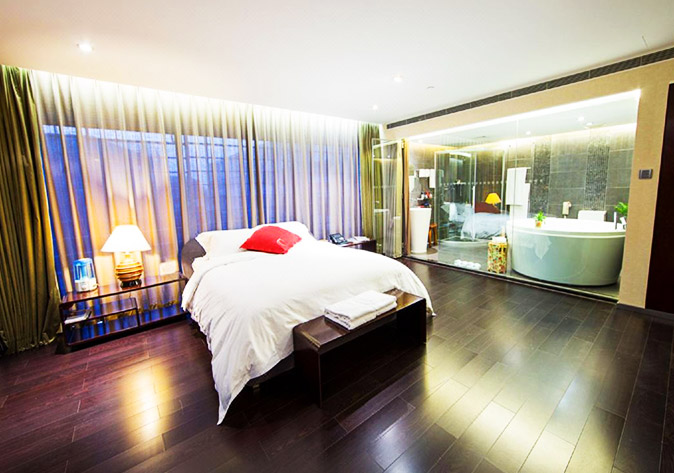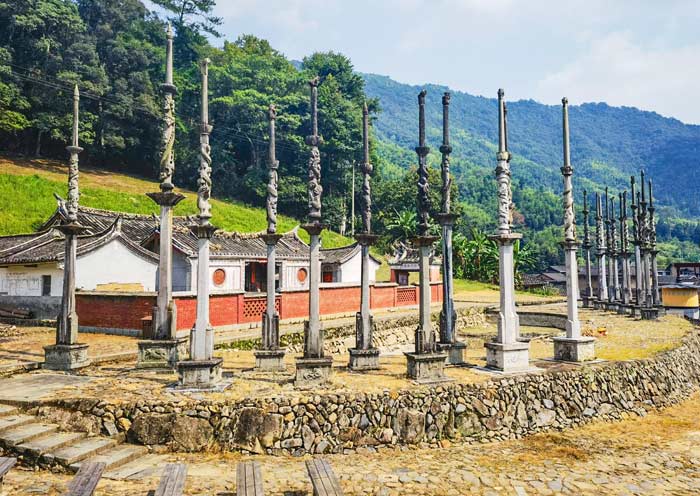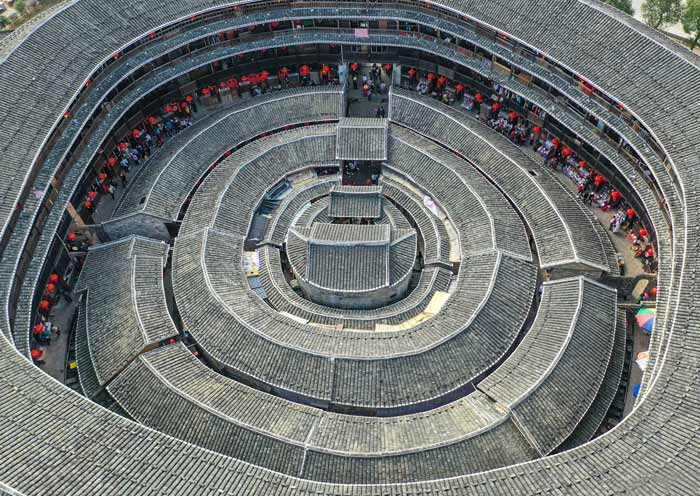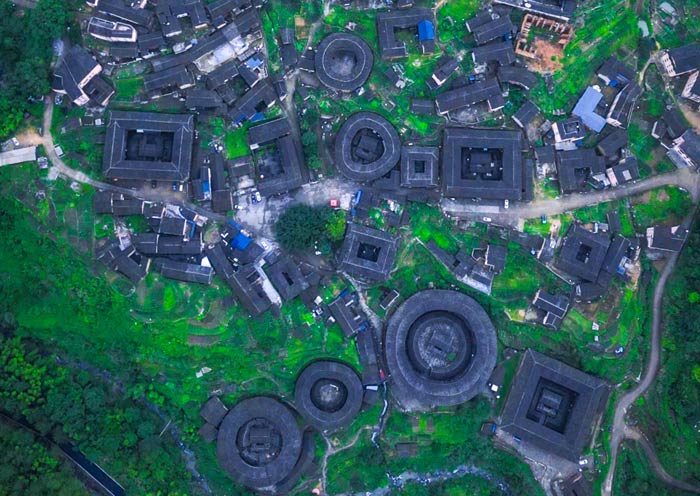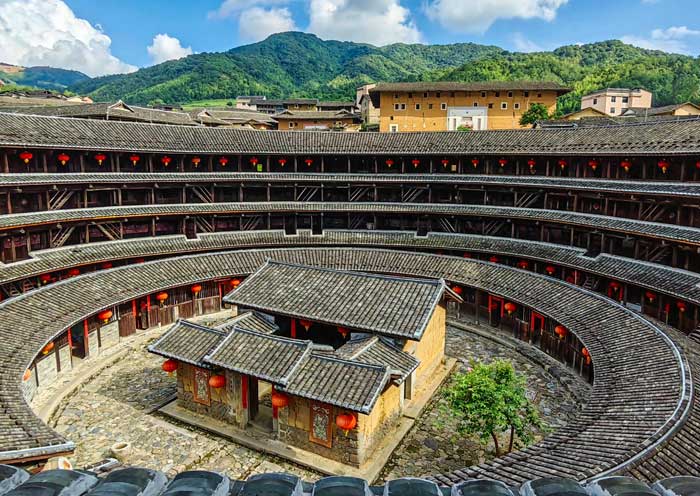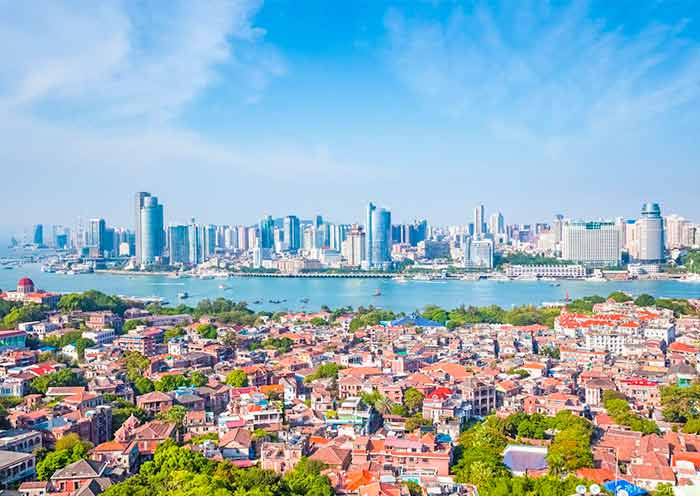This morning, head to Nanjing Hakka Tulou (南靖土楼) from Xiamen City (150km, 2.5 hours drive). You will enjoy a full-day guided tour with us to witness the amazing Fujian Tulou (world Heritage), the masterpiece of traditional Chinese residential buildings built by the Hakka people. You will have fun exploring the Tianluokeng Tulou Cluster, which was mistakenly identified as a “missile weapon base” by America. You can try to discover the hometown of Mulan (花木兰的家) as depicted in the Disney movie at the Hekeng Tulou Cluster. Have a bite of Hakka food and learn more about Hakka culture by visiting Yuchang Building and Taxia Village.
When arrive at Tianluokeng Tulou Cluster(田螺坑土楼群), you will fall in love with the 5 “unique and mythical mountain architectures” surrounded by rice terrace fields, tea bushes, and fruit trees like persimmon. There are over 15,000 Nanjing Tulou buildings, and the Tianluokeng Tulou Cluster is a must-visit with its 5 iconic Hakka Tulou buildings, locally referred to as the "Four Dishes and One Soup" (四菜一汤). It consists of one square Tulou (Buyun Building步云楼; the most common shape among Tulou), one oval Tulou (Wenchang Building文昌楼; the only oval-shaped Tulou in China), and three round Tulou buildings (Hechang Building和昌楼, Zhenchang Building振昌楼, and Ruiyun Building瑞云楼). The round Tulou and square Tulou also represent the Eastern philosophy of "Heaven is round, Earth is square" (天圆地方), the balance of Yin and Yang, as well as the complementary nature of movement and stillness, which depicts the ancient Chinese scientific cognition of the universe. From the upper observation deck (上观景台), you can overlook the Tulou cluster resembling blossoming plum flowers scattered in front of the rice terrace fields, symbolizing the auspicious meaning of "Five Blessings through Plum Blossom Opening" (梅开五福). According to Chinese Fengshui (风水), the arrangement of the five Tulou buildings follows the Five Elements (五行Metal, Wood, Water, Fire, Earth) layout. According to this layout, the four round Tulou buildings—Wenchang Building, Hechang Building, Zhenchang Building, and Ruiyun Building—correspond to the elements of Metal (金), Wood (木), Water (水), and Fire (火), respectively. The central square Tulou, the Buyun Building, corresponds to the Earth (土) element. According to ancient Chinese philosophy, the elements of Fire, Wood, Earth, Metal, and Water represent the blessings of Fortune, Prosperity, Longevity, Happiness, and Wealth (福、禄、寿、喜、财), respectively. The five Tulou buildings mean the fulfillment of these five blessings (五福), representing the Hakka people’s wish for happiness and good fortune. From the lower observation deck (下观景台), you can admire the Tulou Cluster resembling a Fujian version of the "Potala Palace" that stands at the top of the rice terrace fields.
The Tianluokeng Tulou Cluster, initially built in 1662, is now the settlement of around 700 members of the Huang family (Hakka people). All five Tulou buildings face northeast and are oriented southwest. You can explore the first Tulou built in Tianluokeng the "Buyun Building" (步云楼), symbolizing the hope that future generations will excel in education and succeed in their careers. Then visit the subsequent buildings including the "Hechang Building" (和昌楼) representing harmony and prosperity, the "Zhenchang Building" (振昌楼) representing progress and prosperity, the "Wenchang Building" (文昌楼) symbolizing cultural prosperity, and the "Ruiyun Building" (瑞云楼) with auspicious and wealthy connotations. When enter Tulou buildings, you will see each vertical household within the Tulou accommodates one family, with the ground floor serving as the kitchen, the second floor as a granary, and the third floor as bedrooms. There are also shared halls, wells, and courtyards in the central area. The windows on the third floor provide ventilation and natural light, but can also serve as shooting holes in emergencies. Tulou buildings originated during the Song and Yuan dynasties (over 1,700 years ago) and flourished during the late Ming, Qing, and Republic of China periods. The ancestors of the Hakka people came from the Central Plains (中原Henan province) and migrated south to escape wars. They settled in this rugged, wildlife-infested, and bandit-prone area, living in close-knit communities (Hakka Tulou) for self-preservation. Since they were guests from distant lands, they became known as "Hakka people" (客家人).
At lunchtime, you can have a Tulou Hakka family visit to enjoy delicious Hakka food and experience the local Hakka people's lifestyle. Don’t forget to try Hakka rice wine.
After lunch, head to Xiaban Village (下板村), a flat land carved out of the surrounding mountains, where the streams flow joyfully and tea gardens cascade in layers. Twelve Tulou buildings are scattered in an orderly manner on both sides of the streams. You will visit the most renowned Tulou here, the Yuchang Building (裕昌楼). Known as the "Father of Fujian Tulou" (福建土楼之父) and the oldest existing Tulou, the Yuchang Building is hailed as the Tulou version of "Leaning Tower of Pisa" (比萨斜塔), with a maximum tilt of 15°. Completed in 1308, the Yuchang Building was finished several decades earlier than the Leaning Tower of Pisa in Italy (completed in 1372). From the outside, the Yuchang Building's exterior walls are weathered and mottled, resembling an elderly figure who has weathered storms. You will discover that the Tulou is enclosed by outer walls measuring 1-2 meters thick and load-bearing inner walls around 50 centimeters thick. Made primarily of raw earth, it is mixed with lime, fine sand, glutinous rice, brown sugar, bamboo chips, and wooden strips. Through repeated pounding and compacting, the Tulou is constructed, featuring characteristics such as communal living, theft prevention, earthquake resistance, animal deterrents, fire resistance, moisture resistance, ventilation, and natural lighting, ensuring warmth in winter and coolness in summer. Stepping into the Yuchang Building, you will be startled at why it is called the "East Leaning West Tilted Building" (东歪西斜楼). Although the pillars of the third and fourth-floor corridors lean clockwise, while the pillars of the fifth-floor corridor lean counterclockwise, giving it an appearance of being on the verge of collapse, it has endured countless storms over seven hundred years, as well as multiple earthquakes, and remains intact. According to legend, during the construction of the building, the artisans were angered by the lack of care given to them, so they intentionally constructed it this way.
The Yuchang Building (Zigzag Building) is a round Tulou which is not only a product of early joint-stock ownership but also a vivid demonstration of the special sentiment and application of Feng Shui (风水) and the number "five" in ancient Chinese architecture. Yuchang Building was jointly funded and constructed by five clans: Liu, Luo, Zhang, Tang, and Fan. The five clans divided the building into five sections based on their required rooms, with five sets of staircases and five observation decks on the outer walls. This design embodies the philosophical concept of the mutual generation of the five elements in Tulou architecture, promoting harmonious living, and also represents the aspiration for abundant harvests and good fortune. Perhaps because ancient Chinese people often used "five" for counting (with five fingers on each hand and foot) and considered it the largest and auspicious number. Yuchang Building has five floors: the first floor is the kitchen, the second floor is the granary, the third floor is for the elderly, the fourth floor is for the young, and the fifth floor is used for storing coffins. Interestingly, Yuchang Building has the most wells among Fujian Tulou buildings (22 wells). Each kitchen has its own well, allowing easy access to water by simply using a dipper. In the central courtyard of the building, there is a single-story circular ancestral hall, and in front of the hall, there is a Yin-Yang Bagua pattern paved with cobblestones, divided into five sections representing the five elements: metal, wood, water, fire, and earth. The building consists of a total of 269 rooms. At its peak, it housed over 40 households with more than 360 people. Currently, there are 24 households with the surname Liu, totaling 123 residents. You will be invited by the Hakka people to their rooms, have a look at their well, and have a drink of Oolong tea made by the locals while learning more stories and folk culture in Tulou from the owner of the Hakka Castle.
In the afternoon, you can visit the Hekeng Tulou Cluster (河坑土楼群) to find Mulan's hometown as depicted in the Disney movie. It follows the planning and layout concept of "Harmony between Heaven and Earth" and is concentrated within an area of less than 1 square kilometer. It consists of 14 large-scale Tulou buildings (13 of which are listed as World Heritage Sites), making it the most densely populated Tulou cluster in Fujian. From the earliest Chaoshui Building (朝水楼; built in 1549) to the latest Yongqing Building (永庆楼; built in 1972), the construction period spans a remarkable 423 years, reflecting the historical evolution of Tulou formation and development in different eras. The cluster comprises 7 square-shaped Tulou buildings from the Ming and Qing dynasties and 7 round-shaped Tulou buildings built in modern times, forming a spectacular celestial phenomenon resembling the "Big Dipper" (北斗七星) constellation on the ground. The harmonious coexistence of these two groups, the combination of square and round, Ying and Yang, creates a unique landscape that is unparalleled within the Tulou complexes. You can climb the observation deck on the southwest side of Shizi Mountain (Lion Hill) at the entrance of Hekeng Village to capture the panoramic view of the Hekeng Tulou Cluster, a representative museum of Fujian Tulou clusters and a masterpiece of traditional Chinese residential architecture.
Then, move to Taxia Village (塔下村), a Hakka village famous as Minnan Zhouzhuang Water Town in southern Fujian (闽南周庄). With its small bridge, flowing water, and peaceful houses, Tiaxia Village is a village with a history of over 400 years that resembles a secluded paradise. It is not only a renowned overseas Chinese village in Fujian Province but also a famous longevity village. A mountain stream, approximately 1 km long, meanders through the gorge. There are 11 stone arch bridges of various styles on the stream, and along the banks, there are 42 earthen buildings. If you climb to the observation deck on the small hilltop, you will be rewarded with a panoramic view of the "Taiji water village" (Water Town of Taichi). Due to the river forming an S shape, on both sides of the river, centered around two circular Tulou buildings—Yude Building and Shunchang Building—numerous Tulou and charming small brick houses are scattered, making the entire village resemble a Taiji diagram. You can visit the Yude Building by the stream. From the outside, it appears as a complete Tulou, but inside, only half of it is built. The front half-circle has one more floor than the back, resembling a kitchen apron, hence its nickname, "Apron Building" (围裙楼). This Tulou suffered a devastating fire, with evident bullet holes and burn marks on the broken walls. It was later restored by the overseas Chinese. Don't miss Deyuan Tang Hall (德远堂Zhang Clan Ancestral Hall张氏宗祠). According to records, in 1426, the Zhang ancestors settled here, forming a typical Hakka village. In front of the ancestral hall, there is a semicircular pond, and along the pond, 24 stone dragon flagpoles stand tall, reaching up to 10 meters. Only villagers who achieved great accomplishments or centenarians are qualified to have a dragon pillar erected, representing the pride of the clan. Overnight in Taxia Village.
Notes:
1. Visit Tianluokeng Tulou Cluster, you can either hike or take a shuttle bus.
2. Hekeng Tulou Cluster, you will be dropped off at the entrance and will then need to walk for about 15 minutes to reach the main earthen buildings.
3. If you visit Taxia Village in autumn, you will see Hakka people drying persimmon outside Tulou, and the whole village smells sweet.
4. If you are interested in Oolong tea, you can contact us ahead of time for tea leave picking at a local tea plantation around Taxia Village.
5. Both Tianluokeng Tulou Cluster and Chuxi Tulou Cluster are good places to view rice terrace fields and take nice photos.
6. In the Autumn season, you can choose to catch the rare chance to pick up local fruits and even try primitive farm work.








